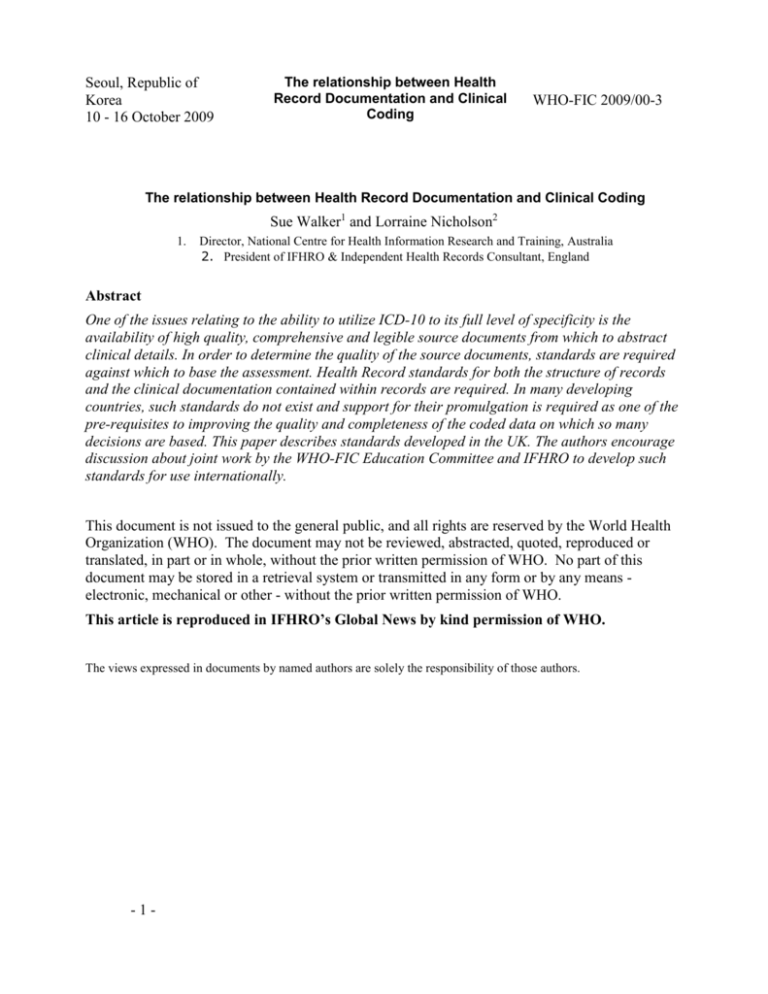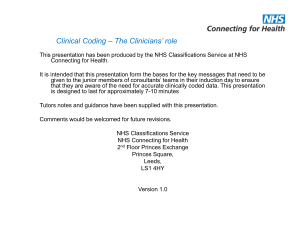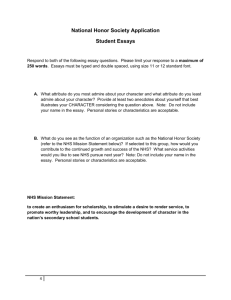
Seoul, Republic of
Korea
10 - 16 October 2009
The relationship between Health
Record Documentation and Clinical
Coding
WHO-FIC 2009/00-3
The relationship between Health Record Documentation and Clinical Coding
Sue Walker1 and Lorraine Nicholson2
1.
Director, National Centre for Health Information Research and Training, Australia
2. President of IFHRO & Independent Health Records Consultant, England
Abstract
One of the issues relating to the ability to utilize ICD-10 to its full level of specificity is the
availability of high quality, comprehensive and legible source documents from which to abstract
clinical details. In order to determine the quality of the source documents, standards are required
against which to base the assessment. Health Record standards for both the structure of records
and the clinical documentation contained within records are required. In many developing
countries, such standards do not exist and support for their promulgation is required as one of the
pre-requisites to improving the quality and completeness of the coded data on which so many
decisions are based. This paper describes standards developed in the UK. The authors encourage
discussion about joint work by the WHO-FIC Education Committee and IFHRO to develop such
standards for use internationally.
This document is not issued to the general public, and all rights are reserved by the World Health
Organization (WHO). The document may not be reviewed, abstracted, quoted, reproduced or
translated, in part or in whole, without the prior written permission of WHO. No part of this
document may be stored in a retrieval system or transmitted in any form or by any means electronic, mechanical or other - without the prior written permission of WHO.
This article is reproduced in IFHRO’s Global News by kind permission of WHO.
The views expressed in documents by named authors are solely the responsibility of those authors.
-1-
WHO-FIC 2009/00-3
1. The Relationship Between Health Record Documentation and the
Quality of Clinical Coding
Clinical coding is the translation of medical terminology as written by the clinician to
describe a patient’s complaint, problem, diagnosis, treatment or reason for seeking
medical attention, into a coded format which is nationally and internationally recognised.
(NHS Connecting for Health, Clinical Coding Instruction Manual) i.e. it is the translation
into code of what has been documented by treating clinical staff.
Coders should not make assumptions but only code what is documented – the accuracy
of clinical coding is dependent on the clinician recording clear and complete diagnostic
and procedural information, avoiding the use of abbreviations, and also on the clinical
coder correctly translating this information into the appropriate coded format to accurately
reflect the patient’s episode of care; therefore the completeness and accuracy of the
coding reflects the quality of the source documentation in addition to the skills and
knowledge of the clinical coder.
2. Why Health Record standards are important
Huffman (1994) defines a Medical (Health) Record as "a compilation of pertinent facts of a
patient's life and health history, including past and present illness(es) and treatment(s),
written by the health professionals contributing to that patient's care. The Health Record
must be compiled in a timely manner and contain sufficient data to identify the patient,
support the diagnosis, justify the treatment, and accurately document the results";
Health Records are basic clinical tools and accurate, complete and timely completion of
the documentation in the record is the personal obligation of clinical professional(s)
treating the patient.
The primary purpose of the Health Record is to facilitate clinical care and the continuity of
that care and it must therefore be easily and quickly retrievable at all times. The record
acts as an aide-memoire for the treating clinician and is also an essential communication
tool where other clinicians or healthcare professionals contribute to the care of the patient
and it facilitates the patient receiving appropriate treatment at the right time. Health
Records provide a permanent account of diagnostic and treatment decisions and a means
by which a clinician’s treatment can be judged. The record provides evidence of what was
done, when and why, and also provides the means to answer questions about diagnosis
and treatment and defend medico-legal claims where necessary.
The secondary purpose of the record is to provide a dependable source of clinical data to
support clinical audit, research, teaching, resource allocation and performance planning
and the link between the primary and secondary purposes of the record is clinical coding.
(Carpenter, Professor Iain et al, 2009, Health Informatics Unit, Royal College of
Physicians, London/Centre for Health Service Studies, University of Kent, Canterbury);
Health Records are the source document for abstracting various clinical data, including
coded data.
-2-
WHO-FIC 2009-003
3. Existing Standards for Health Records
3.1 Types of Existing Standards
There are two types of existing standards for Health Records:
a. Structure of the Health Record - Standards for the organization and configuration
of Health Records are needed so that records are structured appropriately. Health
Records are a chronological record of important events and they need to be
ordered appropriately so that relevant clinical information is recorded in the right
place to enable clinicians to locate it quickly and easily when required. Irrelevant
documents should not be included in the record.
b. Content and completeness of the documentation within the record - Content and
completeness standards apply to the format and definition of what is recorded in
the agreed structure. These standards means that
i. entries in the record are legible,
ii. the authors of entries are attributable i.e. clearly and accurately identifiable,
iii. entries are dated, signed and timed,
iv. any amendments to the record are made transparently,
v. entries in the record are made contemporaneously whenever possible but
as soon as possible after the event/encounter,
vi. there is limited use of abbreviations and jargon
vii. personal or subjective statements are not entered in the record,
viii. documentation of value judgements and speculation is not made, and
ix. irrelevant documents are not included.
Both types of standards are vitally important for clinical coding purposes: the first so that
relevant information required to determine complete and accurate codes can be easily
located; the second because the completeness and accuracy of the coding relies on
content. Structured records will also help to improve ease and accuracy in communication
of clinical information and improve the quality and safety of clinical practice.
3.2 NHS Standards (England) - a case study
The Health Informatics Unit at the Royal College of Physicians in London has coordinated
the development and piloting of nationally agreed standards for the structure and content
of Health Records that have been agreed for all hospital specialties. This project was
funded by NHS Connecting for Health and the standards were ‘signed off’ in April 2008 by
the Academy of Medical Royal Colleges, attended by the Presidents from all the colleges,
including surgical, mental health and child health. The standards were passed as fit for
purpose and observations were made from psychiatry and paediatrics that, although the
information that they required was different from and additional to that covered by the
standardised headings, the requirements for these specialties could be accommodated
within the proposed standards structure.
England has a population of approximately 60 million people and it is the largest of the
four “home countries” which make up the United Kingdom of Great Britain and Northern
Ireland. The National Health Service (NHS) in England had an overall budget for 2007/08
WHO-FIC 2009/00-3
of £96billion. It is the largest employer in Europe and one of the largest in the world
employing 1.3 million people. There are over 600 NHS healthcare provider organisations
and over 35,000 different categories of treatment. Each country in the UK has a National
Health Service and in Northern Ireland there is integrated health and social care. Each of
the four countries has its own approach to the development and implementation of
Electronic Health Records but this section focuses on EHR development in England.
National Electronic Health Records in England are the responsibility of the NHS Care
Records Service (NHS CRS), which is a key component of the National Programme for
Information Technology (NPfIT). This is a £6.2 billion programme which supports the
delivery of the NHS Plan. This plan aims to deliver a patient-centred service, which offers
patients more choice about where and when they will be treated. The NHS Care Records
Service will provide all 60 million NHS patients with an individual electronic NHS Care
Record, which will provide details of key treatments and care within the health service
and/or the social care sector. There are two principal components to the electronic patient
record programme for hospitals in England - the Summary Care Record (held nationally)
and Detailed Care Records (held locally).
The Summary Care Record (SCR)
The Summary Care Record will initially contain only basic information such as major
diagnoses and procedures, current medications, adverse reactions and allergies. It is the
single common set of clinical information about patients which will be accessible to all
authorised health care professionals treating them anywhere in the NHS in England. It is
being constructed from the data in primary care records and is currently being rolled out
across the NHS.
Detailed Care Records
Over the next few years, as the Electronic Patient Record system develops, NHS
organisations which normally work together in a local area e.g. hospitals, clinics and
General Practitioners will develop and begin to link and access detailed electronic records
for each patient. “Early Adopter Trusts” are currently implementing the first hospital
versions of these systems while many General Practices have long established electronic
record systems. It is intended that Health Records will become increasingly paper free and
interoperable so that the validity of the data held will be preserved between systems and
locations.
The standards for Health Records developed by the Royal College of Physicians have
been submitted to NHS Connecting for Health which is responsible for the development of
the national Electronic Patient Record in England (the NHS Care Record) and work on
definitions that will meet the rigorous requirements for IT implementation is currently
underway. Once completed, the definitions will be submitted to the NHS Information
Standards Board for Health and Social Care following which all IT system suppliers to the
NHS will be required to use them for their EPR solutions. Many hospitals and IT suppliers
are already implementing them in both paper and electronic format.
The NHS Digital and Health Information Policy Directorate in England have published a
two part clinician’s guide to the standards:
-4-
WHO-FIC 2009-003
Part 1 - describes the rationale for the process of developing and introducing the national
professional record keeping standards and lists the expected benefits from their
introduction;
Part 2 - contains the Generic Health Record Keeping Standards and the structure and
content standards for admission, handover and discharge documents.
4. The Importance of Standards for Electronic Patient Record
Development
The implementation of electronic patient records in the NHS significantly increases the
importance of structured records and this applies to all EHR systems wherever they are
implemented around the world. In the UK, disease or intervention specific datasets have
been developed by specialist organisations but they often contain different definitions for
the same clinical condition and coverage of clinical encounters is ad hoc. With the
development of electronic patient records there is an increasingly urgent need to
standardise the structure and content of clinical information recorded and communicated
through the Health Record.
Structure and content standards are crucial to ensure that clinical information can be
consistently stored, retrieved and shared between information systems. The standards must
therefore be based on professional agreement that reflects best clinical practice, and then
they must be incorporated into information systems by skilled IT professionals. Patients
must also be involved at all stages of standards development to ensure that the standards
help rather than hinder the process of recording, retrieving and communicating clinical
information. This will ensure that patient care is safer and more efficient and effective.
There is considerable risk if the clinical professions themselves do not identify what these
standards should be, because this would mean that EHR implementations will primarily
reflect the technical standards of pre-existing computer systems, which were developed to
meet administrative and financial needs. These types of systems would then require
clinical input to adapt the systems to meet clinical requirements. This would have serious
implications for the quality, safety and efficiency of clinical practice. It would also slow down
the development and adoption of EHR systems.
The main benefit of structure and content standards in EHR systems is that clinical
information in electronic records will be recorded once, and made available when and
where required, thus improving efficiency and saving time. Implementation of new clinical
information systems will also be simplified; as the systems will all be built on the same
professionally developed and agreed standards for clinical structure and content.
For Health Information Managers and coders, the advantage of structure and content
standards lies in the ability to abstract comprehensive and relevant clinical information on
which to assign the most complete and accurate set of codes to describe the clinical
encounter.
WHO-FIC 2009/00-3
5. Future work
ICD-10 contains the recommended format for the medical certificate of cause of death but
many of the mortality coding rules have been developed to address issues caused by
inadequate documentation of cases. For morbidity coding, volume 2 contains the following:
4.4.1 Guidelines for recording diagnostic information for single-condition analysis
of morbidity data
General
The health care practitioner responsible for the patient's treatment should select the main condition to be
recorded, as well as any other conditions, for each episode of health care. This information should be
organized systematically by using standard recording methods. A properly completed record is essential for
good patient management and is a valuable source of epidemiological and other statistical data on morbidity
and other health care problems. 1
Again, the instructions for morbidity coding have been developed to manage poor
documentation. Having standards for record structure and content would go some way to
addressing poor documentation before it becomes a coding problem.
The availability of standards for Health Records (and potentially other source documents,
such as death certificates) for use internationally would assist with the provision of high
quality coded data. Most countries with well-developed health information systems already
have their own standards. However, small and developing countries in which there are few
trained Health Record professionals may not have access to such standards. Without
standards for Health Records, there is no benchmark against which to assess the quality of
the records and no method by which the results of an assessment can be legitimately
brought to the attention of clinical staff. The authors of this paper suggest that a discussion
about the development of simple, but comprehensive, standards for source documents be
considered as another means to improving coding quality.
1
Extracted from ICD-10 Second Edition, 2005, 4. Rules and guidelines for mortality and
morbidity coding.
-6-









